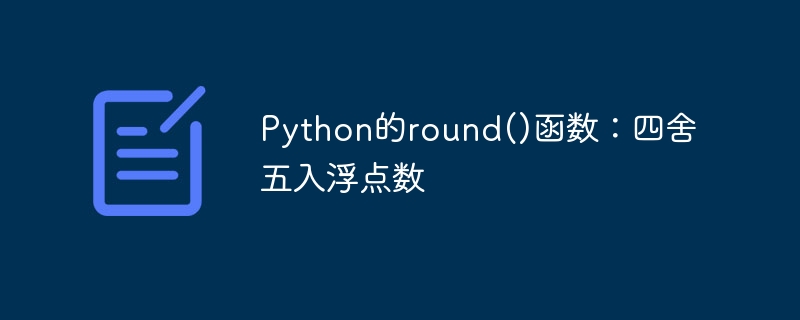

Python's round() function: rounding floating point numbers, specific code examples required
Python is a very popular programming language that provides a wealth of built-in functions as well as Various libraries facilitate developers to perform various data processing and calculation operations. One of the most commonly used built-in functions is the round() function, which is used to round floating point numbers. The syntax of the
round() function is as follows:
round(number[, ndigits])
number is the floating point number to be rounded, ndigits is an optional parameter, used to specify the number of decimal places to retain, the default value is 0 . The round() function rounds the number according to the number of decimal places specified by the ndigits parameter and returns a new floating point number.
The following are several specific examples that demonstrate the use of the round() function:
# 例子1:保留小数点后两位 a = 3.1415926 b = round(a, 2) print(b) # 输出 3.14 # 例子2:不指定保留小数位数 c = 5.6789 d = round(c) print(d) # 输出 6 # 例子3:负数的四舍五入 e = -4.678 f = round(e) print(f) # 输出 -5
In example 1, we retain the floating point number 3.1415926 with two decimal places, and the result is 3.14. In Example 2, we did not specify the ndigits parameter, which defaults to 0 decimal places, so 5.6789 is rounded to 6. In Example 3, we rounded the negative number -4.678 and got -5.
It should be noted that when the round() function performs rounding operations, it follows the principle of "odds are advanced, even are not advanced". That is to say, when the decimal part of the data is exactly 0.5, the round() function will round off the even digits, even if the numbers adjacent to the odd digits should be rounded up by one. For example, for the number 2.5, the round() function will round it, that is, the result is 2; for the number 3.5, the round() function will also round it, that is, the result is 4.
In addition to using integers and decimals as parameters of the round() function in the above examples, you can also use variables, expressions and function return values as parameters. The round() function is very flexible and can meet the needs of different scenarios.
Summary:
Python’s round() function is a very practical built-in function for rounding floating-point numbers. You can flexibly control the number of decimal places retained by specifying the ndigits parameter. When rounding, follow the principle of "odd numbers are rounded, even numbers are not rounded." Whether it is simple numerical calculations or complex data analysis, the round() function can provide convenience and support.
I hope this article will be helpful to understand and use the round() function, and that it can be better used to meet needs in actual programming.
The above is the detailed content of Python's round() function: rounding floating point numbers. For more information, please follow other related articles on the PHP Chinese website!




